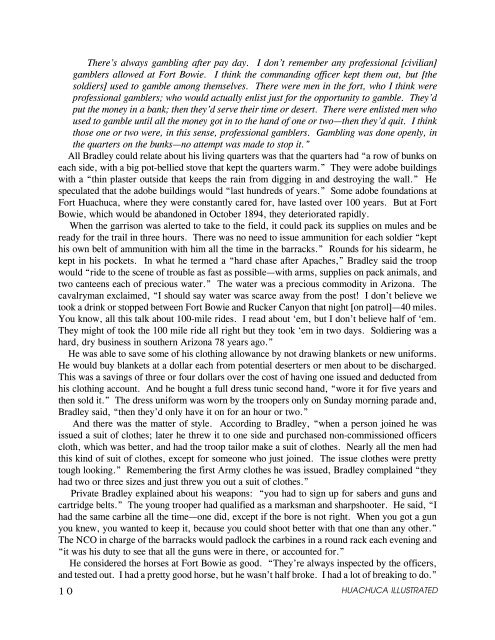Turn of the Century - Fort Huachuca - U.S. Army
Turn of the Century - Fort Huachuca - U.S. Army
Turn of the Century - Fort Huachuca - U.S. Army
- No tags were found...
You also want an ePaper? Increase the reach of your titles
YUMPU automatically turns print PDFs into web optimized ePapers that Google loves.
There’s always gambling after pay day. I don’t remember any pr<strong>of</strong>essional [civilian]gamblers allowed at <strong>Fort</strong> Bowie. I think <strong>the</strong> commanding <strong>of</strong>ficer kept <strong>the</strong>m out, but [<strong>the</strong>soldiers] used to gamble among <strong>the</strong>mselves. There were men in <strong>the</strong> fort, who I think werepr<strong>of</strong>essional gamblers; who would actually enlist just for <strong>the</strong> opportunity to gamble. They’dput <strong>the</strong> money in a bank; <strong>the</strong>n <strong>the</strong>y’d serve <strong>the</strong>ir time or desert. There were enlisted men whoused to gamble until all <strong>the</strong> money got in to <strong>the</strong> hand <strong>of</strong> one or two—<strong>the</strong>n <strong>the</strong>y’d quit. I thinkthose one or two were, in this sense, pr<strong>of</strong>essional gamblers. Gambling was done openly, in<strong>the</strong> quarters on <strong>the</strong> bunks—no attempt was made to stop it.”All Bradley could relate about his living quarters was that <strong>the</strong> quarters had “a row <strong>of</strong> bunks oneach side, with a big pot-bellied stove that kept <strong>the</strong> quarters warm.” They were adobe buildingswith a “thin plaster outside that keeps <strong>the</strong> rain from digging in and destroying <strong>the</strong> wall.” Hespeculated that <strong>the</strong> adobe buildings would “last hundreds <strong>of</strong> years.” Some adobe foundations at<strong>Fort</strong> <strong>Huachuca</strong>, where <strong>the</strong>y were constantly cared for, have lasted over 100 years. But at <strong>Fort</strong>Bowie, which would be abandoned in October 1894, <strong>the</strong>y deteriorated rapidly.When <strong>the</strong> garrison was alerted to take to <strong>the</strong> field, it could pack its supplies on mules and beready for <strong>the</strong> trail in three hours. There was no need to issue ammunition for each soldier “kepthis own belt <strong>of</strong> ammunition with him all <strong>the</strong> time in <strong>the</strong> barracks.” Rounds for his sidearm, hekept in his pockets. In what he termed a “hard chase after Apaches,” Bradley said <strong>the</strong> troopwould “ride to <strong>the</strong> scene <strong>of</strong> trouble as fast as possible—with arms, supplies on pack animals, andtwo canteens each <strong>of</strong> precious water.” The water was a precious commodity in Arizona. Thecavalryman exclaimed, “I should say water was scarce away from <strong>the</strong> post! I don’t believe wetook a drink or stopped between <strong>Fort</strong> Bowie and Rucker Canyon that night [on patrol]—40 miles.You know, all this talk about 100-mile rides. I read about ‘em, but I don’t believe half <strong>of</strong> ‘em.They might <strong>of</strong> took <strong>the</strong> 100 mile ride all right but <strong>the</strong>y took ‘em in two days. Soldiering was ahard, dry business in sou<strong>the</strong>rn Arizona 78 years ago.”He was able to save some <strong>of</strong> his clothing allowance by not drawing blankets or new uniforms.He would buy blankets at a dollar each from potential deserters or men about to be discharged.This was a savings <strong>of</strong> three or four dollars over <strong>the</strong> cost <strong>of</strong> having one issued and deducted fromhis clothing account. And he bought a full dress tunic second hand, “wore it for five years and<strong>the</strong>n sold it.” The dress uniform was worn by <strong>the</strong> troopers only on Sunday morning parade and,Bradley said, “<strong>the</strong>n <strong>the</strong>y’d only have it on for an hour or two.”And <strong>the</strong>re was <strong>the</strong> matter <strong>of</strong> style. According to Bradley, “when a person joined he wasissued a suit <strong>of</strong> clo<strong>the</strong>s; later he threw it to one side and purchased non-commissioned <strong>of</strong>ficerscloth, which was better, and had <strong>the</strong> troop tailor make a suit <strong>of</strong> clo<strong>the</strong>s. Nearly all <strong>the</strong> men hadthis kind <strong>of</strong> suit <strong>of</strong> clo<strong>the</strong>s, except for someone who just joined. The issue clo<strong>the</strong>s were prettytough looking.” Remembering <strong>the</strong> first <strong>Army</strong> clo<strong>the</strong>s he was issued, Bradley complained “<strong>the</strong>yhad two or three sizes and just threw you out a suit <strong>of</strong> clo<strong>the</strong>s.”Private Bradley explained about his weapons: “you had to sign up for sabers and guns andcartridge belts.” The young trooper had qualified as a marksman and sharpshooter. He said, “Ihad <strong>the</strong> same carbine all <strong>the</strong> time—one did, except if <strong>the</strong> bore is not right. When you got a gunyou knew, you wanted to keep it, because you could shoot better with that one than any o<strong>the</strong>r.”The NCO in charge <strong>of</strong> <strong>the</strong> barracks would padlock <strong>the</strong> carbines in a round rack each evening and“it was his duty to see that all <strong>the</strong> guns were in <strong>the</strong>re, or accounted for.”He considered <strong>the</strong> horses at <strong>Fort</strong> Bowie as good. “They’re always inspected by <strong>the</strong> <strong>of</strong>ficers,and tested out. I had a pretty good horse, but he wasn’t half broke. I had a lot <strong>of</strong> breaking to do.”10 HUACHUCA ILLUSTRATED
















